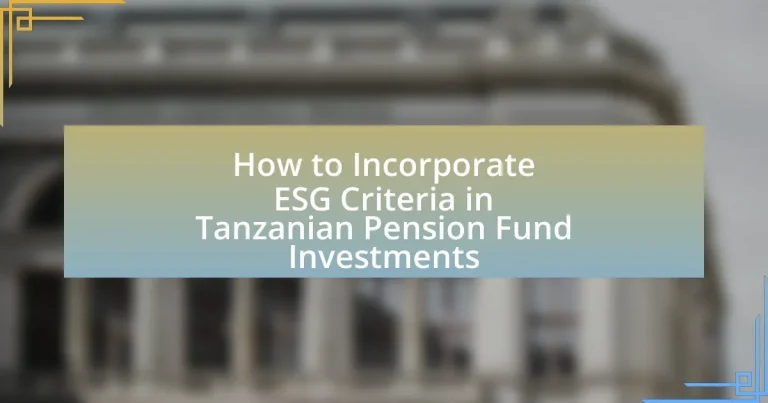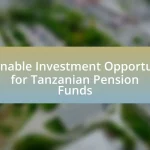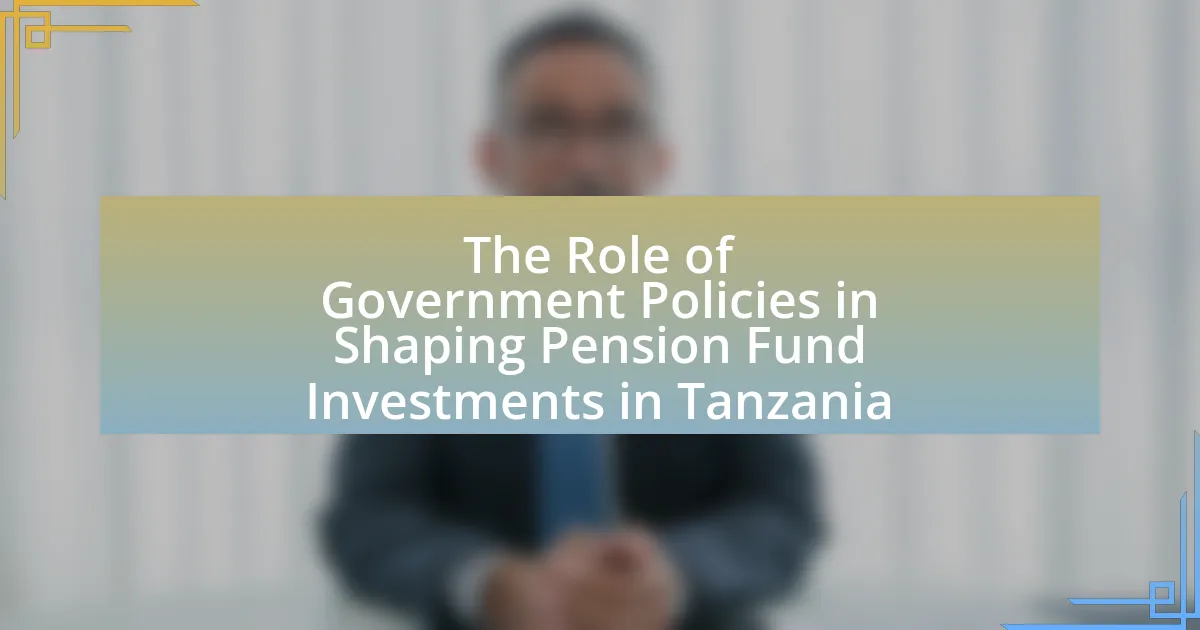The article focuses on the incorporation of Environmental, Social, and Governance (ESG) criteria in Tanzanian pension fund investments. It outlines the significance of ESG factors in assessing investment sustainability and financial performance, highlighting their role in risk management and long-term value creation. Key components of ESG criteria are discussed, along with the challenges pension funds face in integrating these standards, such as the lack of standardized metrics and data availability. The article also addresses common misconceptions about ESG investing, practical steps for effective integration, and the potential benefits of aligning investment strategies with global sustainability trends. Additionally, it emphasizes the importance of stakeholder engagement and adherence to international standards for successful ESG implementation.
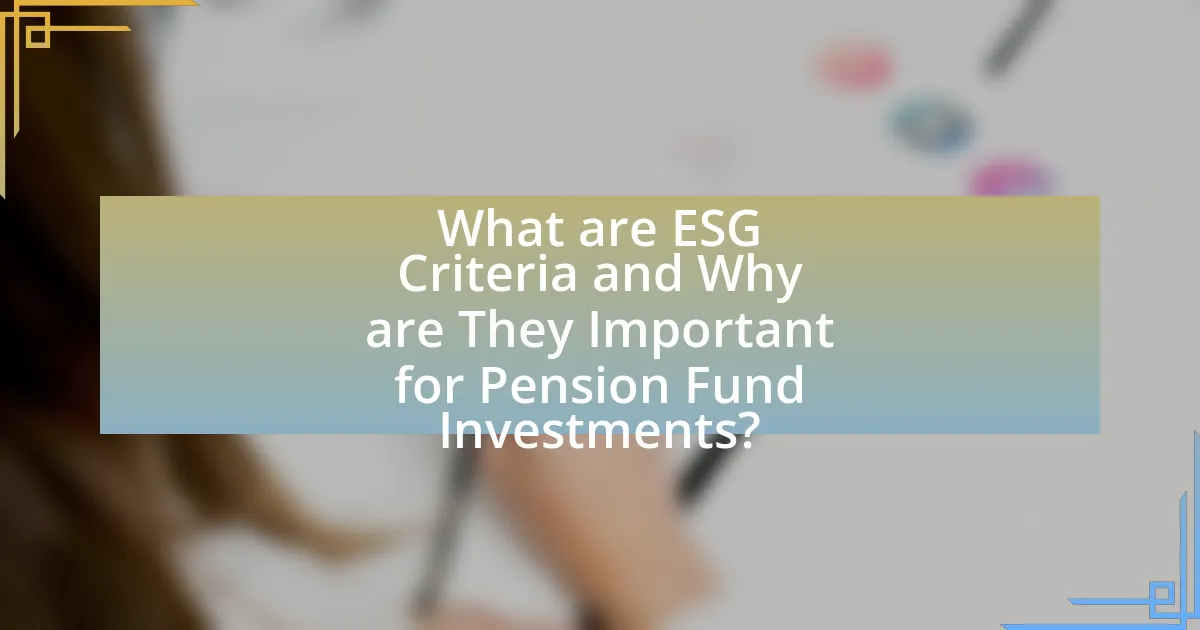
What are ESG Criteria and Why are They Important for Pension Fund Investments?
ESG criteria refer to Environmental, Social, and Governance factors used to evaluate the sustainability and societal impact of investments. These criteria are important for pension fund investments because they help assess risks and opportunities that traditional financial analysis may overlook, ultimately influencing long-term performance and stability. Research indicates that companies with strong ESG practices often exhibit lower volatility and better financial returns, making them attractive for pension funds aiming to secure stable returns for beneficiaries. For instance, a study by MSCI found that companies with high ESG ratings outperformed their lower-rated counterparts during market downturns, highlighting the financial relevance of integrating ESG factors into investment strategies.
How do ESG Criteria influence investment decisions?
ESG criteria significantly influence investment decisions by guiding investors to consider environmental, social, and governance factors alongside traditional financial metrics. Investors increasingly recognize that companies with strong ESG practices tend to exhibit lower risk and better long-term performance. For instance, a study by MSCI found that companies with high ESG ratings outperformed their lower-rated counterparts during market downturns, demonstrating resilience and stability. This trend is evident as institutional investors, including pension funds, integrate ESG criteria into their investment strategies to align with stakeholder values and mitigate risks associated with unsustainable practices.
What are the key components of ESG Criteria?
The key components of ESG Criteria are Environmental, Social, and Governance factors. Environmental criteria assess a company’s impact on the planet, including issues like climate change, resource depletion, and waste management. Social criteria evaluate how a company manages relationships with employees, suppliers, customers, and communities, focusing on aspects such as labor practices, diversity, and human rights. Governance criteria examine a company’s leadership, executive pay, audits, internal controls, and shareholder rights. These components are essential for evaluating the sustainability and ethical impact of investments, guiding investors in making informed decisions that align with their values and risk management strategies.
How do ESG Criteria impact financial performance?
ESG criteria positively impact financial performance by enhancing risk management and driving long-term value creation. Companies that adhere to environmental, social, and governance standards often experience lower capital costs and improved operational efficiencies. For instance, a study by the University of Oxford and Arabesque Partners found that 88% of research indicates that solid ESG practices result in better operational performance, which correlates with higher stock prices. Furthermore, firms with strong ESG profiles tend to attract more investment, as investors increasingly prioritize sustainability, leading to improved financial outcomes.
What challenges do pension funds face in incorporating ESG Criteria?
Pension funds face several challenges in incorporating ESG criteria, primarily due to a lack of standardized metrics for evaluating environmental, social, and governance factors. This absence of uniformity complicates the assessment of investments, making it difficult for pension funds to compare ESG performance across different assets. Additionally, there is often insufficient data available on the ESG practices of companies, which hinders informed decision-making. Furthermore, pension funds may encounter resistance from stakeholders who prioritize short-term financial returns over long-term sustainability goals, creating a conflict between traditional investment strategies and ESG integration. Lastly, regulatory frameworks in many regions, including Tanzania, may not yet fully support or incentivize ESG investments, limiting the ability of pension funds to adopt these criteria effectively.
What are the common misconceptions about ESG investing?
Common misconceptions about ESG investing include the belief that it sacrifices financial returns for ethical considerations, that it is only relevant for certain industries, and that ESG metrics are universally standardized. Research by Morgan Stanley indicates that sustainable equity funds often outperform traditional funds, dispelling the notion that ESG investing compromises returns. Additionally, ESG factors are applicable across all sectors, not just those traditionally viewed as “green” or socially responsible. Lastly, while various organizations provide ESG ratings, the lack of a single, universally accepted framework leads to inconsistencies in how ESG performance is measured, which can mislead investors about the comparability of ESG investments.
How can pension funds overcome barriers to ESG integration?
Pension funds can overcome barriers to ESG integration by adopting a structured approach that includes developing clear ESG policies, enhancing data collection and analysis capabilities, and engaging with stakeholders. Establishing comprehensive ESG policies provides a framework for decision-making and aligns investment strategies with sustainability goals. Improving data collection and analysis allows pension funds to assess ESG risks and opportunities effectively, as evidenced by a 2021 study from the Global Sustainable Investment Alliance, which found that funds with robust data practices outperformed their peers in ESG metrics. Engaging with stakeholders, including asset managers and investee companies, fosters collaboration and encourages the adoption of best practices in ESG integration.
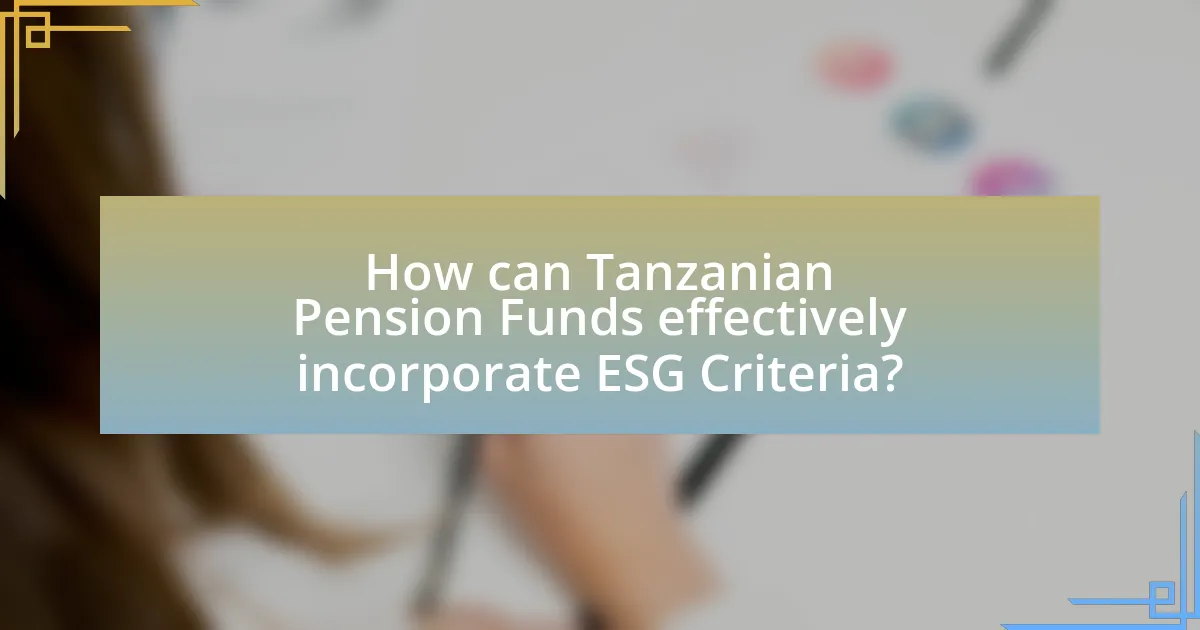
How can Tanzanian Pension Funds effectively incorporate ESG Criteria?
Tanzanian Pension Funds can effectively incorporate ESG criteria by establishing a clear framework that integrates environmental, social, and governance factors into their investment decision-making processes. This can be achieved through the development of specific ESG policies that outline the funds’ commitment to sustainable investing, including criteria for evaluating potential investments based on their ESG performance.
Furthermore, pension funds can engage with companies in their portfolios to encourage better ESG practices, thereby enhancing long-term value and risk management. Research indicates that companies with strong ESG performance tend to have lower capital costs and better operational performance, which supports the financial interests of pension funds. For instance, a study by the Global Sustainable Investment Alliance reported that sustainable investments have grown significantly, indicating a market trend towards prioritizing ESG factors.
By adopting these strategies, Tanzanian Pension Funds can align their investment practices with global sustainability trends while potentially improving their financial returns.
What steps should be taken to integrate ESG Criteria into investment strategies?
To integrate ESG criteria into investment strategies, investors should first establish a clear framework that defines the specific ESG factors relevant to their investment goals. This involves identifying key environmental, social, and governance metrics that align with the fund’s values and objectives. Next, investors should conduct thorough research and analysis to assess potential investments against these ESG criteria, utilizing tools such as ESG ratings and reports from reputable agencies.
Additionally, integrating ESG considerations into the investment decision-making process requires ongoing monitoring and engagement with portfolio companies to ensure compliance with ESG standards. Investors should also consider collaborating with ESG-focused investment managers or consultants to enhance their expertise and access to relevant data.
Finally, transparent reporting on ESG performance and outcomes is essential to demonstrate accountability and attract stakeholders who prioritize sustainable investing. According to a 2020 study by the Global Sustainable Investment Alliance, sustainable investment assets reached $35.3 trillion globally, highlighting the growing importance of ESG integration in investment strategies.
How can pension funds assess potential ESG investments?
Pension funds can assess potential ESG investments by utilizing a combination of quantitative metrics and qualitative evaluations. This involves analyzing ESG ratings provided by specialized agencies, which score companies based on their environmental, social, and governance practices. For instance, funds can reference data from organizations like MSCI or Sustainalytics, which offer comprehensive ESG ratings and reports that detail a company’s performance in these areas. Additionally, pension funds should conduct due diligence by reviewing company disclosures, sustainability reports, and third-party audits to ensure transparency and accountability in ESG practices. This methodical approach allows pension funds to make informed investment decisions that align with their ESG criteria, ultimately contributing to sustainable investment portfolios.
What role do stakeholders play in the ESG integration process?
Stakeholders play a crucial role in the ESG integration process by influencing decision-making and ensuring accountability. Their involvement helps align the interests of various parties, including investors, regulators, and the community, with environmental, social, and governance objectives. For instance, stakeholder engagement can lead to the identification of relevant ESG risks and opportunities, which are essential for informed investment strategies. Research indicates that companies with strong stakeholder engagement practices tend to perform better in ESG metrics, as they are more responsive to societal expectations and regulatory requirements. This alignment ultimately enhances the sustainability and resilience of investment portfolios, particularly in contexts like Tanzanian pension funds, where local stakeholder perspectives are vital for effective ESG integration.
What tools and frameworks are available for ESG integration?
Tools and frameworks available for ESG integration include the Global Reporting Initiative (GRI), Sustainability Accounting Standards Board (SASB) standards, and the Task Force on Climate-related Financial Disclosures (TCFD). The GRI provides a comprehensive framework for sustainability reporting, enabling organizations to disclose their ESG impacts transparently. SASB standards offer industry-specific metrics that help investors assess the sustainability performance of companies. TCFD focuses on climate-related financial risks and opportunities, guiding organizations in reporting relevant information to stakeholders. These frameworks are widely recognized and utilized by investors and companies to enhance ESG integration in investment strategies.
How can pension funds utilize ESG ratings and indices?
Pension funds can utilize ESG ratings and indices to enhance investment decision-making by integrating environmental, social, and governance factors into their portfolio management strategies. By leveraging ESG ratings, pension funds can assess the sustainability and ethical impact of potential investments, which can lead to better risk management and long-term financial performance. For instance, studies have shown that companies with high ESG ratings often exhibit lower volatility and better operational performance, making them more attractive to institutional investors. Additionally, pension funds can track ESG indices to benchmark their portfolios against sustainable investment standards, ensuring alignment with responsible investment goals and regulatory requirements.
What are the best practices for monitoring ESG performance?
The best practices for monitoring ESG performance include establishing clear metrics, integrating ESG factors into investment analysis, and conducting regular assessments. Clear metrics, such as carbon footprint reduction and diversity ratios, provide quantifiable benchmarks for performance evaluation. Integrating ESG factors into investment analysis ensures that these criteria are considered alongside financial metrics, enhancing overall decision-making. Regular assessments, ideally on an annual basis, allow for tracking progress and making necessary adjustments to strategies. According to the Global Sustainable Investment Alliance, sustainable investments reached $35.3 trillion in 2020, highlighting the growing importance of effective ESG monitoring in investment strategies.
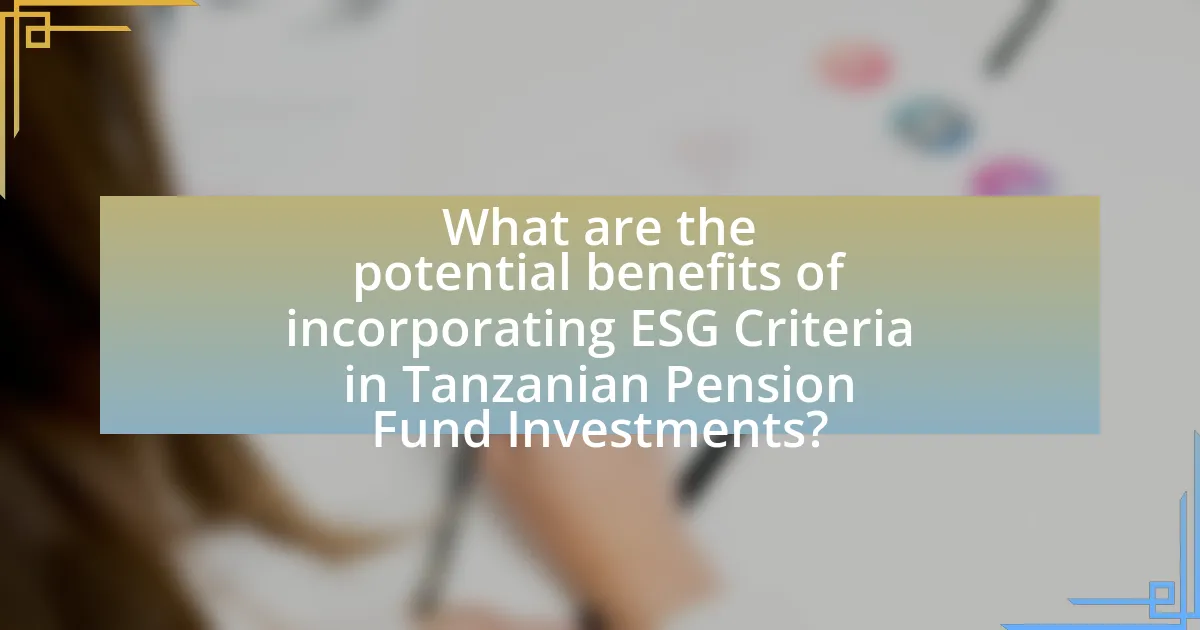
What are the potential benefits of incorporating ESG Criteria in Tanzanian Pension Fund Investments?
Incorporating ESG criteria in Tanzanian pension fund investments can enhance financial performance and mitigate risks. Research indicates that companies with strong ESG practices often exhibit lower volatility and better long-term returns, which is crucial for pension funds that prioritize stable growth for beneficiaries. For instance, a study by the Global Sustainable Investment Alliance found that sustainable investments outperformed traditional investments in various markets, demonstrating the financial viability of ESG integration. Additionally, adopting ESG criteria can improve the reputation of pension funds, attract socially conscious investors, and align with global trends towards sustainability, thereby ensuring compliance with emerging regulatory frameworks.
How can ESG integration enhance risk management?
ESG integration enhances risk management by identifying and mitigating environmental, social, and governance risks that can impact financial performance. By incorporating ESG criteria, organizations can proactively address potential regulatory changes, reputational damage, and operational disruptions. For instance, a study by the Global Sustainable Investment Alliance found that companies with strong ESG practices tend to exhibit lower volatility and better long-term financial performance, indicating that effective ESG integration can lead to more resilient investment portfolios. This approach allows pension funds to safeguard their investments against unforeseen risks while aligning with sustainable development goals.
What are the long-term financial benefits of ESG investing?
The long-term financial benefits of ESG investing include enhanced risk management, improved financial performance, and increased investor interest. Companies that prioritize environmental, social, and governance factors tend to exhibit lower volatility and better resilience during economic downturns, as evidenced by a study from the University of Oxford and Arabesque Partners, which found that 88% of research shows that solid ESG practices result in better operational performance. Furthermore, ESG investments often attract a growing pool of investors who are increasingly prioritizing sustainability, leading to higher demand and potentially better returns. According to a report by MSCI, companies with high ESG ratings have historically outperformed their lower-rated counterparts, demonstrating that integrating ESG criteria can lead to superior long-term financial outcomes.
How does ESG integration contribute to sustainable development in Tanzania?
ESG integration contributes to sustainable development in Tanzania by promoting responsible investment practices that align with environmental, social, and governance criteria. This approach encourages businesses to adopt sustainable practices, which can lead to improved resource management, reduced environmental degradation, and enhanced social equity. For instance, the integration of ESG factors in investment decisions can drive capital towards renewable energy projects, which are crucial for Tanzania’s energy transition and economic growth. Additionally, studies indicate that companies with strong ESG performance often experience lower risks and higher long-term returns, thereby attracting more investment into the Tanzanian market and fostering economic stability.
What are the implications of regulatory frameworks on ESG investing?
Regulatory frameworks significantly shape ESG investing by establishing guidelines that promote transparency, accountability, and sustainability in investment practices. These frameworks, such as the European Union’s Sustainable Finance Disclosure Regulation (SFDR), require asset managers to disclose how they integrate ESG factors into their investment decisions, thereby enhancing investor confidence and encouraging responsible investment. Furthermore, regulations can incentivize companies to adopt sustainable practices by linking access to capital with ESG performance, as seen in various jurisdictions where compliance with ESG standards is tied to favorable financing terms. This regulatory environment ultimately drives the alignment of investment strategies with broader societal goals, fostering a more sustainable economy.
How do local regulations affect ESG integration in Tanzania?
Local regulations significantly influence ESG integration in Tanzania by establishing the legal framework within which businesses operate. The Tanzanian government has implemented various policies aimed at promoting sustainable practices, such as the Environmental Management Act of 2004, which mandates environmental assessments for projects, thereby encouraging companies to adopt ESG principles. Additionally, the Capital Markets and Securities Authority has introduced guidelines that require listed companies to disclose their ESG practices, fostering transparency and accountability. These regulations create an environment that incentivizes pension funds to incorporate ESG criteria into their investment strategies, as compliance with local laws can enhance reputational value and mitigate risks associated with environmental and social issues.
What international standards should Tanzanian pension funds consider?
Tanzanian pension funds should consider the International Financial Reporting Standards (IFRS) and the Principles for Responsible Investment (PRI) as key international standards. IFRS provides a framework for transparent financial reporting, which is essential for pension funds to ensure accountability and attract investment. The PRI offers guidelines for integrating environmental, social, and governance (ESG) factors into investment decision-making, aligning with global best practices for sustainable investing. Adopting these standards can enhance the credibility and performance of Tanzanian pension funds in the global market.
What practical tips can help Tanzanian pension funds successfully incorporate ESG Criteria?
Tanzanian pension funds can successfully incorporate ESG criteria by adopting a structured approach that includes establishing clear ESG policies, engaging with stakeholders, and integrating ESG factors into investment analysis. Establishing clear ESG policies provides a framework for decision-making and ensures alignment with international standards, such as the UN Principles for Responsible Investment. Engaging with stakeholders, including beneficiaries and investment managers, fosters transparency and accountability, which are essential for effective ESG integration. Furthermore, integrating ESG factors into investment analysis allows pension funds to assess risks and opportunities associated with environmental, social, and governance issues, ultimately leading to more sustainable investment outcomes. This approach is supported by evidence that funds incorporating ESG criteria tend to perform better in the long term, as they are better equipped to navigate regulatory changes and societal expectations.
How can pension funds engage with ESG-focused investment managers?
Pension funds can engage with ESG-focused investment managers by establishing clear ESG criteria and integrating these standards into their investment policies. This engagement involves conducting thorough due diligence on potential managers, assessing their ESG performance metrics, and ensuring alignment with the fund’s sustainability goals. Research indicates that pension funds that actively collaborate with ESG managers can enhance portfolio resilience and long-term returns, as evidenced by a 2020 study from MSCI, which found that companies with strong ESG practices often outperform their peers financially.
What resources are available for ongoing ESG education and training?
Ongoing ESG education and training resources include online courses, webinars, and certification programs offered by organizations such as the Global Reporting Initiative (GRI), the Sustainability Accounting Standards Board (SASB), and the CFA Institute. These resources provide structured learning on ESG principles, reporting standards, and investment strategies. For instance, the GRI offers a comprehensive online course on sustainability reporting, while SASB provides training on integrating ESG factors into investment analysis. Additionally, universities and business schools often offer specialized programs focusing on sustainable finance and responsible investing, further enhancing knowledge in this area.
